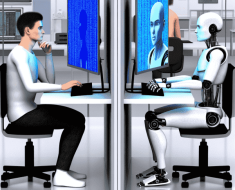
He, Y. et al. Micro-crack behavior of carbon fiber reinforced Fe3O4/graphene oxide modified epoxy composites for cryogenic application. Compos. Part A Appl. Sci. Manuf. 108, 12–22 (2018).
Huang, S. et al. An overview of dynamic covalent bonds in polymer material and their applications. Eur. Polym. J. 141, 110094 (2020).
Utrera-Barrios, S., Verdejo, R. & López-Manchado, M. A. & Hernández Santana, M. Evolution of self-healing elastomers, from extrinsic to combined intrinsic mechanisms: a review. Mater. Horiz. 7, 2882–2902 (2020).
Samadzadeh, M., Boura, S. H., Peikari, M., Kasiriha, S. M. & Ashrafi, A. A review on self-healing coatings based on micro/nanocapsules. Prog. Org. Coat. 68, 159–164 (2010).
Shchukin, D. G. Container-based multifunctional self-healing polymer coatings. Polym. Chem. 4, 4871–4877 (2013).
Canadell, J., Goossens, H. & Klumperman, B. Self-healing materials based on disulfide links. Macromolecules 44, 2536–2541 (2011).
Kuang, X. et al. Facile fabrication of fast recyclable and multiple self-healing epoxy materials through diels-alder adduct cross-linker. J. Polym. Sci. Pol. Chem. 53, 2094–2103 (2015).
Wen, N. et al. Recent advancements in self-healing materials: Mechanicals, performances and features. React. Funct. Polym. 168, 105041 (2021).
Han, Y., Wu, X., Zhang, X. & Lu, C. Self-healing, highly sensitive electronic sensors enabled by metal–ligand coordination and hierarchical structure design. ACS Appl. Mater. Inter. 9, 20106–20114 (2017).
Nardeli, J. V., Fugivara, C. S., Taryba, M., Montemor, M. F. & Benedetti, A. V. Self-healing ability based on hydrogen bonds in organic coatings for corrosion protection of AA1200. Corros. Sci. 177, 108984 (2020).
Liu, T. et al. Ultrafast and high-efficient self-healing epoxy coatings with active multiple hydrogen bonds for corrosion protection. Corros. Sci. 187, 109485 (2021).
Kim, G., Caglayan, C. & Yun, G. J. Epoxy-based catalyst-free self-healing elastomers at room temperature employing aromatic disulfide and hydrogen bonds. ACS omega 7, 44750–44761 (2022).
Bosnian, A., Brunsveld, L., Folmer, B. & Sijbesma, R. & Meijer, E. Macromol. Symp. 201, 143–154 (2003).
Rosero-Navarro, N. C., Pellice, S. A., Durán, A. & Aparicio, M. Effects of Ce-containing sol–gel coatings reinforced with SiO2 nanoparticles on the protection of AA2024. Corros. Sci. 50, 1283–1291 (2008).
Wang, J. et al. Two birds with one stone: Nanocontainers with synergetic inhibition and corrosion sensing abilities towards intelligent self-healing and self-reporting coating. Chem. Eng. J. 433, 134515 (2022).
Fan, Z. et al. Self-healing mechanisms in smart protective coatings: a review. Corros. Sci. 144, 74–88 (2018).
Tao, Q., Xu, P., Li, M. & Lu, W. Machine learning for perovskite materials design and discovery. npj Comput. Mater. 7, 23 (2021).
Li, Z. et al. Machine learning in concrete science: applications, challenges, and best practices. npj Comput. Mater. 8, 127 (2022).
Zhong, X. et al. Explainable machine learning in materials science. npj Comput. Mater. 8, 204 (2022).
Taylor, C. D. & Tossey, B. M. High temperature oxidation of corrosion resistant alloys from machine learning. npj Mater. Degrad 5, 38 (2021).
Li, Q. et al. Long-term corrosion monitoring of carbon steels and environmental correlation analysis via the random forest method. npj Mater. Degrad 6, 1 (2022).
Al-Haik, M. S., Hussaini, M. Y. & Garmestani, H. Prediction of nonlinear viscoelastic behavior of polymeric composites using an artificial neural network. Int. J. Plast. 22, 1367–1392 (2006).
Hatakeyama-Sato, K., Tezuka, T., Umeki, M. & Oyaizu, K. AI-assisted exploration of superionic glass-type Li(+) conductors with aromatic structures. J. Am. Chem. Soc. 142, 3301–3305 (2020).
Askland, K. D. et al. Prediction of remission in obsessive compulsive disorder using a novel machine learning strategy. Int. J. Methods Psychiatr. Res. 24, 156–169 (2015).
Shao, M., Zhu, X.-J., Cao, H.-F. & Shen, H.-F. An artificial neural network ensemble method for fault diagnosis of proton exchange membrane fuel cell system. Energy 67, 268–275 (2014).
Xu, P., Ji, X., Li, M. & Lu, W. Small data machine learning in materials science. npj Comput. Mater. 9, 42 (2023).
Sutojo, T. et al. A machine learning approach for corrosion small datasets. npj Mater. Degrad 7, 18 (2023).
Xiang, K.-L., Xiang, P.-Y. & Wu, Y.-P. Prediction of the fatigue life of natural rubber composites by artificial neural network approaches. Mater. Des. 57, 180–185 (2014).
Menon, A., Thompson-Colón, J. A. & Washburn, N. R. Hierarchical machine learning model for mechanical property predictions of polyurethane elastomers from small datasets. Front. Mater. 6, 87 (2019).
Pruksawan, S., Lambard, G., Samitsu, S., Sodeyama, K. & Naito, M. Prediction and optimization of epoxy adhesive strength from a small dataset through active learning. Sci. Technol. Adv. Mater. 20, 1010–1021 (2019).
Li, D., Liu, J. & Liu, J. NNI-SMOTE-XGBoost: A novel small sample analysis method for properties prediction of polymer materials. Macromol. Theory Simul. 30, 2100010 (2021).
Novikov, I. S., Shapeev, A. V. & Suleimanov, Y. V. Ring polymer molecular dynamics and active learning of moment tensor potential for gas-phase barrierless reactions: Application to S + H2. J. Chem. Phys. 151, 224105 (2019).
Kim, C., Chandrasekaran, A., Jha, A. & Ramprasad, R. Active-learning and materials design: the example of high glass transition temperature polymers. MRS Commun. 9, 860–866 (2019).
Jha, A., Chandrasekaran, A., Kim, C. & Ramprasad, R. Impact of dataset uncertainties on machine learning model predictions: the example of polymer glass transition temperatures. Model. Simul. Mater. Sci. Eng. 27, 024002 (2019).
Mandl, R. Orthogonal Latin squares: an application of experiment design to compiler testing. Commun. ACM 28, 1054–1058 (1985).
Balak, Z. & Zakeri, M. Application of Taguchi L32 orthogonal design to optimize flexural strength of ZrB2-based composites prepared by spark plasma sintering. Int. J. Refract. Met. H. 55, 58–67 (2016).
Wu, C. J. & Hamada, M. S. Experiments: planning, analysis, and optimization. (John Wiley & Sons), (2011).
Breiman, L. Random forests. Mach. Learn. 45, 5–32 (2001).
Ji, Y. et al. Random forest incorporating ab-initio calculations for corrosion rate prediction with small sample Al alloys data. npj Mater. Degrad 6, 83 (2022).
Packwood, D. Bayesian Optimization for Materials Science. 11-28 (Springer), (2017).
Wagner, T., Emmerich, M., Deutz, A. & Ponweiser, W. in Parallel Problem Solving from Nature, PPSN XI: 11th International Conference, Kraków, Poland, September 11-15, 2010, Proceedings, Part I 11. 718-727 (Springer).
Mohanty, T., Chandran, K. & Sparks, T. D. Machine learning guided optimal composition selection of niobium alloys for high temperature applications. APL Mach. Learn. 1, 036102 (2023).
Cui, G. et al. Research progress on self-healing polymer/graphene anticorrosion coatings. Prog. Org. Coat. 155, 106231 (2021).
Nawaz, M., Habib, S., Khan, A., Shakoor, R. A. & Kahraman, R. Cellulose microfibers (CMFs) as a smart carrier for autonomous self-healing in epoxy coatings. N. J. Chem. 44, 5702–5710 (2020).
Zhang, C., Wang, H. & Zhou, Q. Preparation and characterization of microcapsules based self-healing coatings containing epoxy ester as healing agent. Prog. Org. Coat. 125, 403–410 (2018).
Wang, T. et al. Photothermal nanofiller-based polydimethylsiloxane anticorrosion coating with multiple cyclic self-healing and long-term self-healing performance. Chem. Eng. J. 446, 137077 (2022).
Zheng, N., Fang, G., Cao, Z., Zhao, Q. & Xie, T. High strain epoxy shape memory polymer. Polym. Chem. 6, 3046–3053 (2015).
Li, J., Rodgers, W. R. & Xie, T. Semi-crystalline two-way shape memory elastomer. Polymer 52, 5320–5325 (2011).
Oliveira, C. & Ferreira, M. Ranking high-quality paint systems using EIS. Part I: intact coatings. Corros. Sci. 45, 123–138 (2003).
Hao, Y., Sani, L. A., Ge, T. & Fang, Q. Phytic acid doped polyaniline containing epoxy coatings for corrosion protection of Q235 carbon steel. Appl. Surf. Sci. 419, 826–837 (2017).
Liu, T. et al. Self-healing and corrosion-sensing coatings based on pH-sensitive MOF-capped microcontainers for intelligent corrosion control. Chem. Eng. J. 454, 140335 (2023).
Tavandashti, N. P. et al. Inhibitor-loaded conducting polymer capsules for active corrosion protection of coating defects. Corros. Sci. 112, 138–149 (2016).
Zheng, X., Zheng, P. & Zhang, R.-Z. Machine learning material properties from the periodic table using convolutional neural networks. Chem. Sci. 9, 8426–8432 (2018).
De Myttenaere, A., Golden, B., Le Grand, B. & Rossi, F. Mean absolute percentage error for regression models. Neurocomputing 192, 38–48 (2016).
Fukutani, T., Miyazawa, K., Iwata, S. & Satoh, H. G-RMSD: Root mean square deviation based method for three-dimensional molecular similarity determination. Bull. Chem. Soc. Jpn. 94, 655–665 (2021).
Uyanık, T., Karatuğ, Ç. & Arslanoğlu, Y. Machine learning approach to ship fuel consumption: A case of container vessel. Transp. Res. D.-T. E. 84, 102389 (2020).
Chen, S., Cao, H., Ouyang, Q., Wu, X. & Qian, Q. ALDS: An active learning method for multi-source materials data screening and materials design. Mater. Des. 223, 111092 (2022).
Faraji Niri, M., Reynolds, C., Román Ramírez, L. A. A., Kendrick, E. & Marco, J. Systematic analysis of the impact of slurry coating on manufacture of Li-ion battery electrodes via explainable machine learning. Energy Storage Mater. 51, 223–238 (2022).
Bishop, C. M. & Nasrabadi, N. M. Pattern Recognition and Machine Learning. 4 (Springer), (2006).




